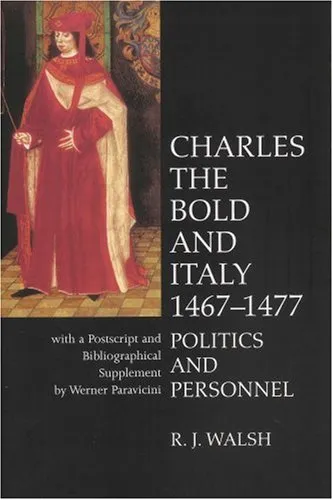Charles the Bold and Italy 1467-1477: Politics and Personnel (Liverpool University Press - Liverpool Historical Studies)
4.5
Reviews from our users

You Can Ask your questions from this book's AI after Login
Each download or ask from book AI costs 2 points. To earn more free points, please visit the Points Guide Page and complete some valuable actions.Introduction to "Charles the Bold and Italy 1467-1477: Politics and Personnel"
"Charles the Bold and Italy 1467-1477: Politics and Personnel" offers a compelling examination of the Burgundian duke's engagement with the complex political landscape of Italy during the tumultuous late 15th century. In this meticulously researched work, I delve into the intricate relationships, ambitions, and strategies that underpinned Charles the Bold’s interactions with Italian states. This study bridges the gap between Burgundian and Italian history during a transformative period in European politics.
The book not only explores the dynamics of diplomacy and war but also sheds light on the individuals who played crucial roles in shaping cross-border relations. Readers are introduced to the networks of power, the personal motivations of key figures, and the broader implications of Burgundian-Italian ties for the balance of power in Renaissance Europe. With its scholarly yet accessible style, the book is a treasure trove for historians, students, and anyone intrigued by the intersection of personalities and politics in pre-modern Europe.
Summary of the Book
The narrative begins in the late 1460s when Charles the Bold, then Duke of Burgundy, sought to bolster his position through engagement with Italy, a region fragmented into numerous states yet rich in culture, commerce, and influence. By examining key moments over the decade—marked by alliances, conflicts, and diplomatic maneuvering—the book illuminates the Duke's ambitions to expand his influence south of the Alps.
We delve into Charles’s methods of forging ties with Italian leaders, including the influential Medici of Florence, the powerful Sforza of Milan, and the Papal States. These relationships were not only political but often deeply personal, showcasing the intricate dance of Renaissance diplomacy. Against a backdrop of shifting alliances and burgeoning state rivalries, the book illustrates how Charles the Bold’s plans resonated far beyond the Burgundian court, impacting broader European politics.
Much attention is paid to the personnel involved in this diplomatic circuit, including envoys, military commanders, and trusted advisors. Their stories bring texture and humanity to the grand narrative of Renaissance geopolitics. By the time of Charles’s tragic fall at the Battle of Nancy in 1477, the seeds he had sown in Italy had far-reaching consequences, reverberating across the continent even after his demise.
Key Takeaways
- Charles the Bold envisioned Italy as a critical arena for asserting Burgundian influence, blending military ambitions with cultural and diplomatic aspirations.
- The book illustrates the complexity of Renaissance diplomacy, emphasizing the interplay between individual agency and broader political trends.
- Through an in-depth focus on personnel, the book highlights the critical roles played by intermediaries, advisors, and envoys in Charles’s Italian strategy.
- The narrative underscores the interconnectedness of European politics, as events in Burgundy, Italy, and beyond were all tightly interwoven during the 15th century.
Famous Quotes from the Book
"Charles the Bold’s vision for Burgundy extended far beyond its northern borders; it reached into the sunny, contested lands of Italy, where opportunity and peril walked hand in hand."
"If Renaissance diplomacy was an art form, then Charles and his Italian counterparts were among its most skilled practitioners—balancing ambition, pragmatism, and the ever-present specter of betrayal."
Why This Book Matters
This book provides a much-needed perspective on a relatively underexplored aspect of European history. While Charles the Bold is often remembered for his campaigns in northern Europe and his fateful final battle, his activities in Italy reveal a broader vision and a more intricate web of connections than many assume. The inclusion of Italian politics expands our understanding of Renaissance diplomacy, highlighting the crucial role of seemingly peripheral figures in shaping continental history.
The interdisciplinary approach—drawing on political history, biography, and international relations—ensures that the book appeals to a wide audience. At its heart, it serves as a reminder that the stories of the past are woven together not only by momentous events but also by the ambitions, decisions, and mistakes of remarkable individuals.
Free Direct Download
Get Free Access to Download this and other Thousands of Books (Join Now)
For read this book you need PDF Reader Software like Foxit Reader
Accessing books through legal platforms and public libraries not only supports the rights of authors and publishers but also contributes to the sustainability of reading culture. Before downloading, please take a moment to consider these options.
Find this book on other platforms:
WorldCat helps you find books in libraries worldwide.
See ratings, reviews, and discussions on Goodreads.
Find and buy rare or used books on AbeBooks.


